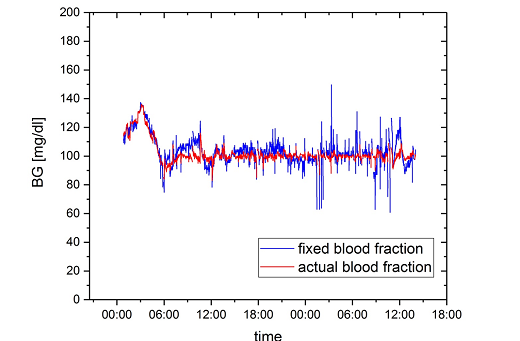Continuous Glucose Concentration Measurement
A continuous glucose monitor (CGM) is a sensor that automatically determines the blood glucose concentration at regular intervals (quasi continuous). Typical intervals range from 1 to 15 minutes which equals 60 to 4 glucose values per minute. The blood glucose can be measured directly in the veins (invasive sensors or intra venous (iv)-sensors) or in other body compartments like subcutaneous tissue, tear fluid, saliva (minimal invasive sensors). The most common and commercial available CGMs measure the interstitial glucose concentration and convert the obtained interstitial glucose values to blood glucose values by a suitable calibration.
In most cases this calibration has to be repeated in regular intervals by common finger prick measurements with a home glucose testing device (self-monitoring of blood glucose, SMBG). The iv sensors are restricted to clinical use by health care professionals because a direct access to a vein is mandatory. The typical setup for iv-sensing is to place the glucose sensor outside the subject, to pump the blood from the vein to the sensor, determine the blood glucose concentration and pump the blood back to the vein or discard it. The advantage of having direct access to the venous blood is the fact that no vein to interstitial fluid kinetics of the glucose concentration and therefore no conversion of the interstitial glucose concentration to venous blood glucose concentration have to be considered.

But on the other hand all glucose sensors on the market cannot measure glucose concentration in whole blood. One way to prepare the venous blood for sensing is a dilution with a special buffer fluid. This procedure is adopted from professional laboratory devices for point-of-care glucose concentration measurements. By diluting the venous blood the glucose concentration becomes lower and it is crucial for precise measurements to control the diluting process. In principle there are two different ways to take the necessary dilution into account: The professional laboratory glucose measuring devices ensure that the dilution is exactly the same for every single measurement and this fixed dilution can be included into the calculation of the true blood glucose concentration from the dilution. For continuously measuring devices it is difficult to assure a constant mixing over several hours because of the very small flow rates and the pulsatile nature of the used tubing pumps.
In our ClampArt® device, a proprietary development of Profil, Neuss, Germany for automated glucose clamps which is CE-marked and licensed for use in Europe the blood glucose concentration is measured continuously and values are obtained every minute [1]. For the iv-approach the dilution process was optimized and in parallel a method to monitor the dilution i.e. the blood fraction simultaneously with the glucose concentration was developed. For the investigation of the influence of the actual blood fraction on the precision of the obtained blood glucose concentration measurements the precision of the BG values from the optimized setting with the BG precision obtained from the same setting with additional consideration of the actual dilution was investigated.
Methods:
The BG concentration is calculated using the following formula:

For a precise BG measurement the actual blood fraction as well as the actual glucose concentration should be independently measured otherwise the BG result might be affected by changes in the blood fraction of the dilution. To evaluate the difference in clamp quality parameters [1] between glucose measurements in a glucose clamp setting with and without considering changes of the actual blood fraction, BG values calculated with and without the use of the measured blood fraction were compared.

For the post-hoc comparison glucose clamp values obtained by the ClampArt® device which uses the actual blood fraction when calculating BG were used. For comparison the BG values (= BGfixed) for each minute of the same glucose clamp experiment using a fixed blood fraction i.e. the blood fraction measured at the beginning of the clamp were recalculated by using the following formula:

The glucose clamp study used for this comparison was performed using ClampArt®. The clamp qualities of continuous BG measurements with and without correction of blood dilution was compared in 95 glucose clamp experiments with in total 155.689 BG values which equals 2595h of glucose clamp data.
Results:
For each glucose clamp experiment the precision, i.e. the standard deviation of BG, was calculated for both the original BG and the recalculated BG with fixed blood fraction. The difference between the obtained BG values and a reference method (Super GL, Dr. Müller, Freital, Germany) gives the accuracy of measurements expressed as mean absolute relative difference (MARD), and the mean difference from the target level the control deviation. Mean (± standard deviation) for the individual glucose clamp quality parameters are given in the table below:
| Clamp quality parameter | Fixed Blood Fraction | Actual Blood Fraction |
| Precision [mg/dl] | 9.6 ± 3.6 | 3.7 ± 1.3 |
| Control deviation [mg/dl] | -2.6 ± 4.2 | 0.2 ± 0.2 |
| Accuracy / MARD [%] | 8.1 ± 2.9 | 4.1 ± 0.8 |
By considering blood dilution for the determination of the BG concentration in automated glucose clamps the mean precision is about three times higher, the control deviation is nearly zero and the accuracy is almost two times higher.
Conclusion and Outlook:
Correcting blood glucose measurements for blood dilution for the determination of BG values in automated clamps significantly enhances measurement (and thereby glucose clamp) quality.
One of the reasons for the high glucose clamp quality achieved with ClampArt® therefore is the correction of BG measurements for the actual blood fraction.
Reference:
[1] Benesch C, Heise T, Klein O, Heinemann L, Arnolds S. How to Assess the Quality of Glucose Clamps? Evaluation of Clamps Performed With ClampArt a Novel Automated Clamp Device. J Diabetes Sci Technol 2015; 9: 792-800




